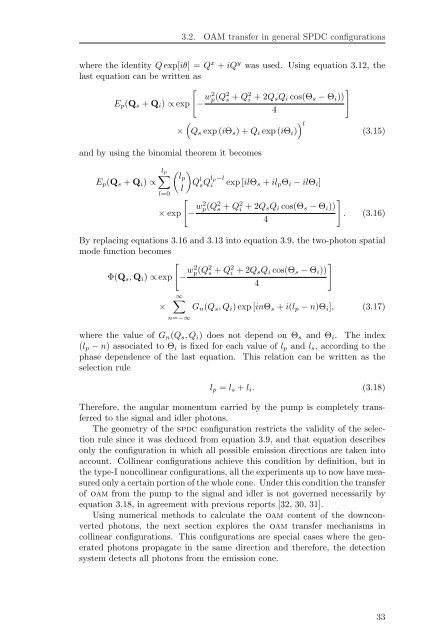Spatial Characterization Of Two-Photon States - GAP-Optique
Spatial Characterization Of Two-Photon States - GAP-Optique
Spatial Characterization Of Two-Photon States - GAP-Optique
Create successful ePaper yourself
Turn your PDF publications into a flip-book with our unique Google optimized e-Paper software.
3.2. OAM transfer in general SPDC configurations<br />
where the identity Q exp[iθ] = Q x + iQ y was used. Using equation 3.12, the<br />
last equation can be written as<br />
<br />
Ep(Qs + Qi) ∝ exp − w2 p(Q2 s + Q2 i + 2QsQi<br />
<br />
cos(Θs − Θi))<br />
4<br />
<br />
l × Qs exp (iΘs) + Qi exp (iΘi)<br />
and by using the binomial theorem it becomes<br />
(3.15)<br />
lp<br />
<br />
lp<br />
Ep(Qs + Qi) ∝ Q<br />
l<br />
l=0<br />
l sQ lp−l<br />
i exp [ilΘs + ilpΘi − ilΘi]<br />
<br />
× exp − w2 p(Q2 s + Q2 i + 2QsQi<br />
<br />
cos(Θs − Θi))<br />
. (3.16)<br />
4<br />
By replacing equations 3.16 and 3.13 into equation 3.9, the two-photon spatial<br />
mode function becomes<br />
<br />
Φ(Qs, Qi) ∝ exp − w2 p(Q2 s + Q2 i + 2QsQi<br />
<br />
cos(Θs − Θi))<br />
4<br />
∞<br />
× Gn(Qs, Qi) exp [inΘs + i(lp − n)Θi], (3.17)<br />
n=−∞<br />
where the value of Gn(Qs, Qi) does not depend on Θs and Θi. The index<br />
(lp − n) associated to Θi is fixed for each value of lp and ls, according to the<br />
phase dependence of the last equation. This relation can be written as the<br />
selection rule<br />
lp = ls + li. (3.18)<br />
Therefore, the angular momentum carried by the pump is completely transferred<br />
to the signal and idler photons.<br />
The geometry of the spdc configuration restricts the validity of the selection<br />
rule since it was deduced from equation 3.9, and that equation describes<br />
only the configuration in which all possible emission directions are taken into<br />
account. Collinear configurations achieve this condition by definition, but in<br />
the type-I noncollinear configurations, all the experiments up to now have measured<br />
only a certain portion of the whole cone. Under this condition the transfer<br />
of oam from the pump to the signal and idler is not governed necessarily by<br />
equation 3.18, in agreement with previous reports [32, 30, 31].<br />
Using numerical methods to calculate the oam content of the downconverted<br />
photons, the next section explores the oam transfer mechanisms in<br />
collinear configurations. This configurations are special cases where the generated<br />
photons propagate in the same direction and therefore, the detection<br />
system detects all photons from the emission cone.<br />
33



